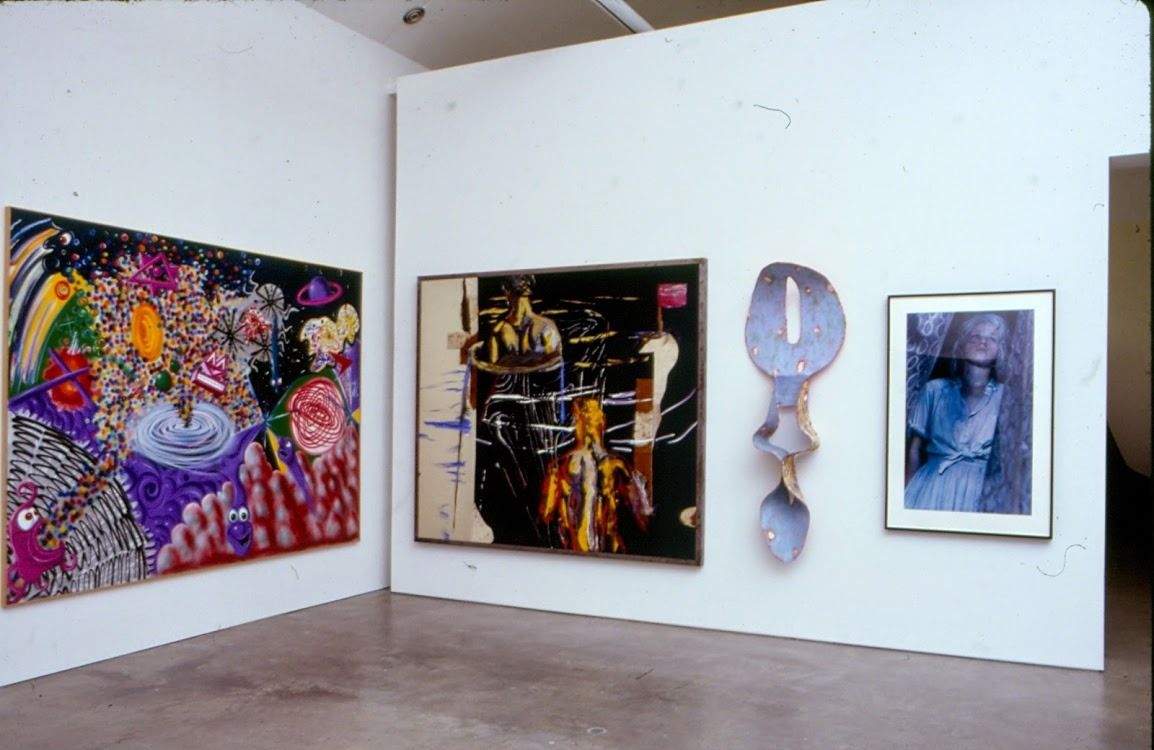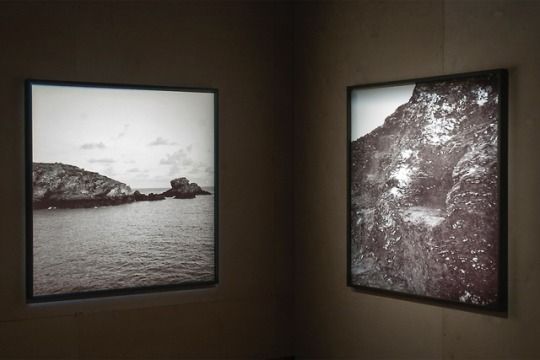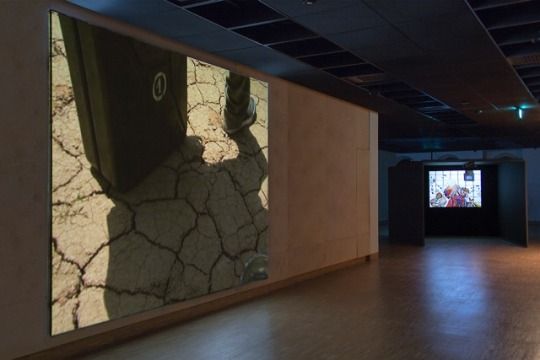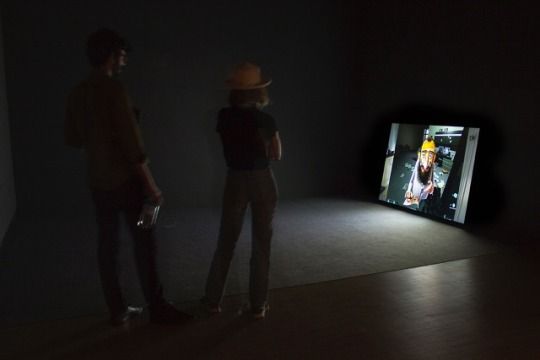Collection Exhibitions - Exhibiting Collections
ZEYNEP ÖZ
3 Temmuz 2015

Kenny Scharf, Richard Schnabel, unknown and Cindy Sherman. Installation view from Exhibited curated by Vasıf Kortun, 1994. Photo: Vasıf Kortun, 1994
In our first year at Bard College, we were tasked with making a collection exhibition: The Center for Curatorial Studies at Bard has been endowed with the Marieluise Hessel Collection from its foundation in 1992, which was the ‘tool’ (to use an education- based term) the students were to use in learning to make exhibitions. It made sense, after all, since the origin of the word is ‘curare’, meaning ‘to take care of’ and the word had been mainly used within the context of taking care of a collection until the end of the 1980s. Since then the popular use of the word mainly referred to a person who would make exhibitions of contemporary art, rather than work on a regular basis with a collection.
For me as well as my classmates, the 1st year exhibition was a tough one as the structure and the process were strange. We had to work with the artist-curator Matthew Higgs who had just curated a show from the Marieluise Hessel Collection. We would make a ‘response exhibition,’ an iteration from the one he had made over the summer-the derivative exhibition. The issue of taste came up a lot in our class conversations: How were we supposed to make an exhibition if we didn’t like the ‘taste’ of Ms. Hessel? And how were we supposed to respond to Mr. Higgs if we didn’t like his configuration of the collection? The derivative of a derivative taste. The Higgs exhibition was called “Exhibitionisms” and our 1st year exhibition was called “Second Thoughts.” Tongue in cheek. Through some sneaky maneuver, I made sure to skip being involved in the collection exhibition. Now, I wish I hadn’t. In the contemporary art realm, making a collection exhibition inevitably involves scrutinizing collecting practices and the nature of the collection. Working on a collection exhibition, one cannot but think of the collection’s foundational conditions as well as the conditions of the collection’s building.
Six years later, and working in a geography that is not replete with museum collections of contemporary art, the challenge to think of alternative ways of making a collection exhibition is a welcome one. The recent exhibition at SALT Beyoğlu, Every Inclusion is an Exclusion of Other Possibilities, touches on this issue. “Every inclusion… brings together aspects of three private, independent collections in order to open a dialogue and critique around the act of collecting and to publicly share the works they have come to hold… We live in a country where there are no public collections of contemporary visual practice overseen by the state. We also lack publicly funded collecting institutions. The material memory of contemporary art in Turkey resides in various degrees of privacy. Less than a handful of privately run institutions bear both the burden and delineate the field of contemporary art. Save for a few, personal collections are either unwieldy, short of clear vision, or remain out of sight stowed away in storages or hanging on the walls of private residences.”
The three collections, which are the subject of this exhibition, are indeed three of the most courageous private collections of recent contemporary art in Istanbul. As such, their sum sheds a certain light on the status of art practice in Istanbul in the last decade. Of course, as they are private collections, they are subject to each collector’s taste, as mentioned in the case of Ms. Hessel above. But then again, come to think of it, the relationship between public museum’s collections and individual/individual patron’s tastes become multi layered as well in this day and age (keeping in mind the relationship between museum collections and collection committees). Hence, taking the issue of taste aside, one starts to wonder what it would mean for a public contemporary art museum (which is lacking in Istanbul) to hold a collection exhibition and of course, along with that the issue of ownership also comes up.

Staying with that line of thought, one of the first questions that came to mind in the context of Every inclusion… is: if SALT were to have a collection, what would it look like (Vasıf Kortun in his talk on the opening day of the exhibition explains why SALT definitively chose not to have one, as the fate of private institutions’ collections have always been precarious in this city). A second question is whether the supposed inaugural collection exhibition looks any similar to the one on view right now? Let’s take as a given the fact that at least a version of this exhibition would indeed be on view since the works seen in the show are daring works, which are defined by the contexts in which art making took place around Istanbul post 2000s.
As SALT selects and includes certain pieces from the three collections for the exhibition, and specifically excludes other ones, it is actually making a map for the contemporary art history in Istanbul through that process. A map of the various contexts and thematic veins in the art history of Istanbul. Some of the forerunning themes are violence, sexuality, their confrontation and contextualization on the third floor. On the second floor, we see the themes of the ‘original’ in the context of image making, as well as social movements and unrest. There are also two mini solo-shows, of Christodoulos Panayiotou and of Emre Hüner in the exhibition.

In a way, Every Inclusion is an Exclusion of Other Possibilities is an exhibition of exhibitions (or exhibitionisms). It shows the various possibilities that a curator might have with these three collections (eg. to work with the theme of sexuality, or work with solo artists whose practice you find noteworthy and whose works were collected profoundly by one of the collectors). But more importantly, the exhibition hints at a curious way of making a collection exhibition, which is essentially map-making. If a certain institution is in a condition to make a collection exhibition without owning the works, then why should it own them in its own collection? Instead, why not choose a two-fold method: First, make a map of contemporary art practices in order to both make the works visible and also available to the general public for scholarly study, and secondly, let the private collectors do the ‘curare/caring’ for the actual physical (and sometimes and mostly the digital) works themselves. Of course, in order for this model to work, collecting would have to be seen outside of the ownership aspect and more as guardianship of public property and this view would have to be an item of public discussion.
Every Inclusion… takes me back to an exhibition that Vasıf Kortun had curated years back at the Museum of the Center for Curatorial Studies, Bard College in 1994: Exhibited. The exhibition revolved around a single work of Thomas Struth’s, Louvre IV (1989), from the Rivendell Collection, which was the name of the Marieluise Hessel Collection at the time. There were six galleries, and thus six takes on what it meant to display a collection work in the galleries. As Kortun explained, the nature of the Rivendell Collection allowed for this collection to be scrutinized as a ‘type’ rather than deal directly with the actuality of it. Instead of talking about the ‘symbolic violence of exclusionary collections,’ that exhibition was an attempt to talk about over-representations and absences.
Exhibited was definitively toying with ideas of what it means to have a museum collection, using the art pieces that were in the collection. A second room in particular was interesting as it explored ideas of exhibition making in the 19th century: In particular it took after the 1874 exhibition of “Impressionism,” in which all the works were installed at the same height and in the order of the artists’ names. As Kortun underlines, the strict formality with which the works were hung and the lengths to which this second room went to look at each work with the same light and conditions actually had a reverse effect: The formality pushed the peculiarities of the collection to come forth even more. Questions around provenance and ownership came under more scrutiny in light of the wide range of quality of the artworks, and the audience was asked to question the modes of collecting building, including but not restricted to the nature of donations.

Exhibited was scrutinizing a particular collection in order to think of alternative modes of collection making. The exhibition was talking about the obstacles and restrictions laid out in front of an institution when the institution decides to ‘own’ a collection. It was also a note to the audience that a collection exhibition always has to be aware of the nature of the museum’s collection. After all, how could an institution be transparent without stating out loud its own restrictions? The restrictions of a museum collection, which we are used to circumventing around as institutional professionals, actually would cease to be restrictions if pointed out from the beginning. If we take as a given that each (private or public) contemporary art collection is a form of art history writing, the second gallery at Exhibited was questioning collection building practices and thereof, proposed modes of art history writing.
Now, thinking about Every inclusion… in light of Exhibited, we can conclude that this later exhibition is actually proposing a new form of a collection exhibition and of collection building and therefore a new form of art history writing. If Exhibited was organized in 1994 in a small town in New York with the aim to underline the institutional problems of dealing with a collection, Every inclusion… organized by SALT some 20 years later and in Istanbul using the institution’s privileged access to private collections hints at the possibilities of mapping collections and collecting practices and making these public without building an institutional collection itself.
For me as well as my classmates, the 1st year exhibition was a tough one as the structure and the process were strange. We had to work with the artist-curator Matthew Higgs who had just curated a show from the Marieluise Hessel Collection. We would make a ‘response exhibition,’ an iteration from the one he had made over the summer-the derivative exhibition. The issue of taste came up a lot in our class conversations: How were we supposed to make an exhibition if we didn’t like the ‘taste’ of Ms. Hessel? And how were we supposed to respond to Mr. Higgs if we didn’t like his configuration of the collection? The derivative of a derivative taste. The Higgs exhibition was called “Exhibitionisms” and our 1st year exhibition was called “Second Thoughts.” Tongue in cheek. Through some sneaky maneuver, I made sure to skip being involved in the collection exhibition. Now, I wish I hadn’t. In the contemporary art realm, making a collection exhibition inevitably involves scrutinizing collecting practices and the nature of the collection. Working on a collection exhibition, one cannot but think of the collection’s foundational conditions as well as the conditions of the collection’s building.
Six years later, and working in a geography that is not replete with museum collections of contemporary art, the challenge to think of alternative ways of making a collection exhibition is a welcome one. The recent exhibition at SALT Beyoğlu, Every Inclusion is an Exclusion of Other Possibilities, touches on this issue. “Every inclusion… brings together aspects of three private, independent collections in order to open a dialogue and critique around the act of collecting and to publicly share the works they have come to hold… We live in a country where there are no public collections of contemporary visual practice overseen by the state. We also lack publicly funded collecting institutions. The material memory of contemporary art in Turkey resides in various degrees of privacy. Less than a handful of privately run institutions bear both the burden and delineate the field of contemporary art. Save for a few, personal collections are either unwieldy, short of clear vision, or remain out of sight stowed away in storages or hanging on the walls of private residences.”
The three collections, which are the subject of this exhibition, are indeed three of the most courageous private collections of recent contemporary art in Istanbul. As such, their sum sheds a certain light on the status of art practice in Istanbul in the last decade. Of course, as they are private collections, they are subject to each collector’s taste, as mentioned in the case of Ms. Hessel above. But then again, come to think of it, the relationship between public museum’s collections and individual/individual patron’s tastes become multi layered as well in this day and age (keeping in mind the relationship between museum collections and collection committees). Hence, taking the issue of taste aside, one starts to wonder what it would mean for a public contemporary art museum (which is lacking in Istanbul) to hold a collection exhibition and of course, along with that the issue of ownership also comes up.

Installation view: Christodoulos Panayiotou, Le Fauteuil de Sarah Bernhardt. Every Inclusion is an Exclusion of other Possibilities, SALT Beyoğlu. Photo: Mustafa Hazneci, 2015
Staying with that line of thought, one of the first questions that came to mind in the context of Every inclusion… is: if SALT were to have a collection, what would it look like (Vasıf Kortun in his talk on the opening day of the exhibition explains why SALT definitively chose not to have one, as the fate of private institutions’ collections have always been precarious in this city). A second question is whether the supposed inaugural collection exhibition looks any similar to the one on view right now? Let’s take as a given the fact that at least a version of this exhibition would indeed be on view since the works seen in the show are daring works, which are defined by the contexts in which art making took place around Istanbul post 2000s.
As SALT selects and includes certain pieces from the three collections for the exhibition, and specifically excludes other ones, it is actually making a map for the contemporary art history in Istanbul through that process. A map of the various contexts and thematic veins in the art history of Istanbul. Some of the forerunning themes are violence, sexuality, their confrontation and contextualization on the third floor. On the second floor, we see the themes of the ‘original’ in the context of image making, as well as social movements and unrest. There are also two mini solo-shows, of Christodoulos Panayiotou and of Emre Hüner in the exhibition.

Installation view: Works by Emre Hüner in Every Inclusion is an Exclusion of other Possibilities, SALT Beyoğlu. Photo: Mustafa Hazneci, 2015
In a way, Every Inclusion is an Exclusion of Other Possibilities is an exhibition of exhibitions (or exhibitionisms). It shows the various possibilities that a curator might have with these three collections (eg. to work with the theme of sexuality, or work with solo artists whose practice you find noteworthy and whose works were collected profoundly by one of the collectors). But more importantly, the exhibition hints at a curious way of making a collection exhibition, which is essentially map-making. If a certain institution is in a condition to make a collection exhibition without owning the works, then why should it own them in its own collection? Instead, why not choose a two-fold method: First, make a map of contemporary art practices in order to both make the works visible and also available to the general public for scholarly study, and secondly, let the private collectors do the ‘curare/caring’ for the actual physical (and sometimes and mostly the digital) works themselves. Of course, in order for this model to work, collecting would have to be seen outside of the ownership aspect and more as guardianship of public property and this view would have to be an item of public discussion.
Every Inclusion… takes me back to an exhibition that Vasıf Kortun had curated years back at the Museum of the Center for Curatorial Studies, Bard College in 1994: Exhibited. The exhibition revolved around a single work of Thomas Struth’s, Louvre IV (1989), from the Rivendell Collection, which was the name of the Marieluise Hessel Collection at the time. There were six galleries, and thus six takes on what it meant to display a collection work in the galleries. As Kortun explained, the nature of the Rivendell Collection allowed for this collection to be scrutinized as a ‘type’ rather than deal directly with the actuality of it. Instead of talking about the ‘symbolic violence of exclusionary collections,’ that exhibition was an attempt to talk about over-representations and absences.
Exhibited was definitively toying with ideas of what it means to have a museum collection, using the art pieces that were in the collection. A second room in particular was interesting as it explored ideas of exhibition making in the 19th century: In particular it took after the 1874 exhibition of “Impressionism,” in which all the works were installed at the same height and in the order of the artists’ names. As Kortun underlines, the strict formality with which the works were hung and the lengths to which this second room went to look at each work with the same light and conditions actually had a reverse effect: The formality pushed the peculiarities of the collection to come forth even more. Questions around provenance and ownership came under more scrutiny in light of the wide range of quality of the artworks, and the audience was asked to question the modes of collecting building, including but not restricted to the nature of donations.

Installation view: Jordan Wolfson, Animation Masks, 2011. Every Inclusion is an Exclusion of other Possibilities, SALT Beyoğlu.Photo: Mustafa Hazneci, 2015
Exhibited was scrutinizing a particular collection in order to think of alternative modes of collection making. The exhibition was talking about the obstacles and restrictions laid out in front of an institution when the institution decides to ‘own’ a collection. It was also a note to the audience that a collection exhibition always has to be aware of the nature of the museum’s collection. After all, how could an institution be transparent without stating out loud its own restrictions? The restrictions of a museum collection, which we are used to circumventing around as institutional professionals, actually would cease to be restrictions if pointed out from the beginning. If we take as a given that each (private or public) contemporary art collection is a form of art history writing, the second gallery at Exhibited was questioning collection building practices and thereof, proposed modes of art history writing.
Now, thinking about Every inclusion… in light of Exhibited, we can conclude that this later exhibition is actually proposing a new form of a collection exhibition and of collection building and therefore a new form of art history writing. If Exhibited was organized in 1994 in a small town in New York with the aim to underline the institutional problems of dealing with a collection, Every inclusion… organized by SALT some 20 years later and in Istanbul using the institution’s privileged access to private collections hints at the possibilities of mapping collections and collecting practices and making these public without building an institutional collection itself.

